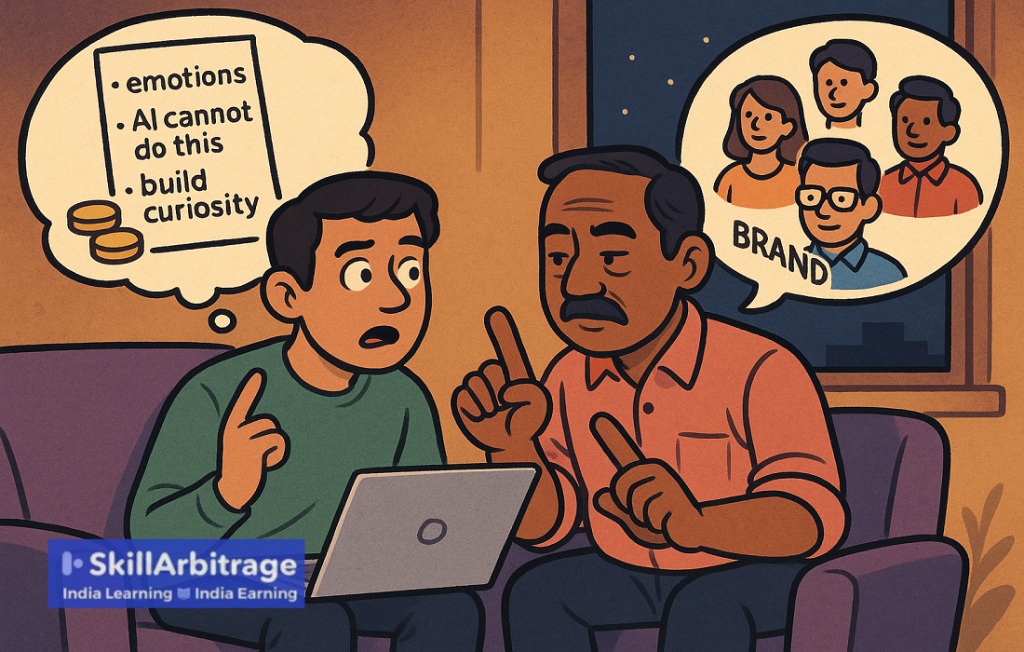This article shows you how to stand out as a beginner by using the human element, emotion, storytelling, and deep insight that machines like AI cannot replicate. By focusing on personalized, human-centered services like voice audits and cultural calibration, you will shift from being just another freelancer to a trusted partner.
Table of Contents
Previously on Packaging Proof…
Raja learned that quiet wins don’t speak for themselves. Raghunandan showed him how to turn scattered results into sharp proof, packaged, positioned, and impossible to ignore.
But proof only works if you get the chance to show it.
Now Raja faces a deeper problem: what do you do when AI writes faster and cheaper freelancers flood the inbox?
Parvathishankar teaches him how beginners win when the odds are rigged.
(Continued…)
The rooftop was glowing. String lights overhead, the scent of marigolds in the breeze, laughter cutting through the jazz. Swathi and Raghunandan’s first anniversary was everything their story had earned—an evening of ease, grace, and gold-rimmed glasses.
But Raja stood by the railing, untouched drink in hand, watching the stars like they owed him an explanation.
He smiled when people passed and nodded when someone cracked a joke. But his eyes, always flicking back to his phone, betrayed him.
When the guests left and the music faded, Parvathishankar didn’t go home.
He walked up behind Raja, like a slow storm.
“You’re not here,” he said quietly. “Why?”
Market at the bottom is broken
Raja didn’t pretend.
“I did everything,” he exhaled. “Raghunandan taught me the three hiring filters. Swathi showed me the basics of branding. I turned my old work into proof, just like Raghunandan said.”
“And still?” Parvathishankar asked.
“I’m either getting ghosted… or insulted. $10 for five pages. AI-written outlines with ‘Just make it better’ notes. People are acting like I am replaceable before I have even begun.”
He turned to the older man, the frustration raw now.
“What’s the point of learning all this if the game is rigged?”
Market has split, and nobody warned the newcomers
Parvathishankar didn’t answer.
He just leaned on the railing beside him.
“What kind of clients are you chasing?” he asked.
Raja blinked.
“Mostly the ones that post in groups. Facebook. Slack. Job boards. I check every day. Reply to everything. Some look promising. But then they send me these weird prompts… vague briefs, two-line outlines. And everything is urgent. Like they expect it by midnight. For coffee money.”
“Do they ever ask about the business problem?” Parvathishankar asked.
Raja shook his head.
“No. Just ‘fix this,’ or ‘add flavor,’ or ‘make it less AI.’ Half the time I don’t even know who their customer is.”
Parvathishankar looked out into the night.
“That’s not a client,” he said. “That’s a churn machine.”
He let the silence do its work.
Then slowly, he raised two fingers.
“There are two markets now,” he said.
“Two completely different ecosystems.”
“One,” he continued, “where brands hire strategic thinkers. People who influence direction. Who get embedded into the team, into the DNA.”
He folded one finger.
“And another, bloated, bottom-heavy, algorithm-ruled, where clients don’t see humans. Just outputs.”
“That’s the one I’m stuck in,” Raja said quietly.
Parvathishankar nodded.
“It’s not that you’re not good,” he said.
“It’s that you’re being measured by the wrong metrics.”
Speed. Price. Scalability.
Metrics built for machines. Not minds.
Section 1. Why emotion beats automation
Parvathishankar’s words landed. He just stood there, eyes on the dark.
Then quietly, almost offhand:
“Have you ever cried reading ChatGPT’s copy?”
Raja blinked.
“No.”
Parvathishankar nodded.
“Exactly.”
He tapped the railing once, like underlining a thought.
“AI can write. But it can’t relive. It doesn’t grieve. Doesn’t fall in love. Doesn’t carry memory in its muscle.”
Raja stared out at the skyline, the question forming slow and stubborn.
“So… what can I do that it can’t?”
“Feel,” Parvathishankar said. “And let the reader feel it too.”
It starts with a story
Inside, the music was fading out. The last of the staff was clearing up plates.
Raja pulled out his phone again to open a client brief he’d been ignoring all week. A yoga teacher. Wanted a homepage rewrite. Said her site felt cold. Corporate. Like it belonged to someone else.
Swathi passed by, catching his screen.
“That one’s easy,” she said. “She doesn’t want a rewrite. She wants to feel seen.”
Parvathishankar raised an eyebrow.
“You’ve already got your answer.”
Raja hesitated.
Then sat down on the balcony floor, back against the wall, and opened a blank note.
“Tell me why you started,” he typed to her. “Not the business story. The real one.”
He sent it. Waited.
A minute later, the three dots danced.
Then a message dropped in.
“it was raining. just moved to blr. no job, no friends, no clue what i was doing. walked into a yoga class just to get outta my head. that day… something lifted. hasn’t left since.”
Raja read it again. And again.
Then he began to write. As someone who knew what it felt like to want your own story back.
Micro-strategy: emotionally anchored copy
He ditched the headlines about “balance” and “inner peace.”
Instead, he opened with the monsoon. The apartment. The ache of drifting.
He used:
- Before/After framing: “You’re not just learning yoga. You’re remembering who you were before the noise.”
- Origin hook: “It started in the rain, in a city that didn’t yet feel like home.”
- Cultural familiarity: Words like “shanti” used not as exotic props but as living language she already loved.
He read it aloud once.
Just the truth.
When he looked up, both Swathi and Parvathishankar were watching.
“No AI’s going to write that,” Swathi said.
Parvathishankar smiled.
“Exactly. Machines scale. You connect.”
Raja didn’t say anything.
But he saw it.
For the first time in weeks, he didn’t feel like a failure. It felt like something had landed.
Not in an inbox. Not in a spreadsheet.
In someone’s memory.
And that’s what clients stay for. Proof that someone still writes with their hands dipped in lived experience.
Swathi nudged him gently.
“Now check your DMs.”
He did.
And smiled.
The yoga trainer wanted a meeting. She didn’t just reply. She remembered something, too. And that made two of them.
Section 2. Jobs AI still can’t touch
Raja sat on the floor, back against the wall, phone in hand, still staring at that one message:
Because for the first time in weeks, he wasn’t just thinking about what to write.
He was thinking about what to offer.
Parvathishankar was still beside him, watching the night sky like it was a textbook.
“Most beginners offer what’s easy to reject,” he said.
“You send a cold pitch: ‘I write blogs.’
They say: ‘AI does that.’
You say: ‘I’ll make it better.’
They say: ‘We’ll try ChatGPT first.’”
Raja nodded.
“So what do I offer instead?”
Parvathishankar tapped the floor gently with his fingers.
“Things AI still can’t do. Things that feel human from the first second. You don’t need to be a veteran. You just need to ask better questions.”
Start offering these 3 human-only services
1. Voice audit offer
What it is:
A free or low-cost Loom video (5–10 minutes) where you review a brand’s website or Instagram and point out where their voice feels off, cold, inconsistent, or generic.
What to say in your DM or email:
“Hey, I noticed something interesting on your site. The tone you’re using doesn’t match the emotional hook your product clearly has. Would it be helpful if I sent over a short video explaining what I mean?”
What it proves:
- You get their audience better than they do.
- You’re not just another writer begging for a gig.
- You can read tone like a strategist, not a typist.
What to watch for:
Say their audience is “women in their 30s navigating burnout,” but the site sounds like it was written by ChatGPT in CEO mode? Point that out. With examples. Clearly.
2. Story extraction sessions
What it is:
A 30-minute Zoom where you ask them 3–5 simple questions to help them find their real voice and story. You don’t promise deliverables. You promise clarity.
What to ask:
- “When did this become real for you?”
- “If your best friend explained your business, what would they say?”
- “What have people said after working with you that really stuck with you?”
What to say in your pitch:
“Before I write anything, I’d love to do a short session where we figure out the real story behind your brand. No fluff, no sales tricks. Just the truth that makes everything else easier.”
What it proves:
You’re not guessing. You’re listening. That makes you feel safer than AI and more insightful than a cheap freelancer.
3. Cultural calibration workshops
What it is:
A one-call breakdown of where a brand’s voice is mismatched with its audience, especially across cultures.
When to offer it:
- When a US brand is trying to “sound Indian,” and it feels forced
- When Indian brands are trying to “go global” and end up losing their soul
What to say:
“Right now, your copy sounds like you’re speaking English at your audience. I can help you sound like you’re speaking from where they live, think, and feel.”
What you show them:
- What their current copy says to someone outside their team
- Where it’s working, and where it’s falling flat
- 1–2 better ways to phrase it using their own words from a story session
You don’t need a Portfolio. You need a Pulse.
Parvathishankar stood up and stretched, slow and quiet.
“You don’t need 10 testimonials to do this,” he said.
“You just need one skill most people forget to use.”
Raja looked up.
“What’s that?”
“Curiosity.”
“Start asking questions machines don’t know how to ask. That’s how you stop being replaceable.”
The string lights above flickered once. The wind shifted.
Raja picked up his phone and opened Instagram.
He wasn’t looking for jobs anymore.
He was looking for voices that didn’t sound like they belonged to anyone.
Section 3: Productizing to escape the “Rate Per Hour” trap
Raja had always thought low pricing was polite.
That it showed humility. That it gave clients one less reason to say no.
But Parvathishankar didn’t flinch when he said it:
“Low pricing isn’t humble. It’s fatal.”
Raja blinked.
“I thought I was being fair.”
“You were being invisible,” Parvathishankar replied. “In pricing, low doesn’t signal value. It signals uncertainty. That you’re unsure of the outcome.”
He leaned forward, elbows on knees.
“Pricing is not about your skill. It’s about how clearly you understand the outcome.”
Productized micro-offers
1. The “First 100 Words” offer
What it is:
A punchy rewrite of just the first 100 words of any page. It could be home, about, sales, or even a LinkedIn bio. Enough to prove your chops and build momentum.
What you say:
“If the first 100 words don’t hook them, nothing else matters. Let’s nail those first.”
Why this works:
You reduce risk. Instead of selling a full page, you sell a turning point. Clients feel safe trying you out, and once they see it working, they almost always come back for the rest.
2. The “Story → Structure” blueprint
What it is:
You take notes from a story session and turn them into a content outline for a sales page, landing page, or even an ad sequence.
What you say:
“You don’t need copy yet. You need clarity. Let’s map your message before we write a word.”
Why this works:
It flips the freelancer dynamic. You become the strategist. The one who sees the forest before touching a single tree. AI can spit out drafts, but it can’t map real emotion to structure.
3. The “Lost to Found” rewrite sprint
What it is:
You take one piece of clunky content, like a dusty About page or a lifeless founder bio, and make it sound like an actual human.
What you say:
“Right now, this sounds like LinkedIn wrote it. I’ll help it sound like you.”
Why this works:
Founders often hate how they sound online but don’t know how to fix it. You show up with empathy, clarity, and voice. You don’t need a portfolio. Your sample is the transformation.
Outcome-based pricing copy
These offers don’t just look different, they read different too.
You don’t say:
- “500 words, 3-day delivery”
- “Includes 2 revisions”
- “SEO blog on topic of choice”
You say:
- “Turn cold traffic into curious readers”
- “Make your homepage sound like your heartbeat”
- “Write like someone who knows exactly who they are”
Each offer describes a felt shift, not a technical output. That’s what makes you irreplaceable.
Raja scrolled through his own site, deleting every mention of “pricing starts at…” and “packages available on request.”
It felt like throwing out old clothes that never fit.
Parvathishankar stood up, brushing coconut crumbs from his kurta.
“You don’t rise in this game by writing more,” he said. “You rise by making choices.”
“Choices?”
“About what you sell. How you name it. What problem it solves. You’re not a writer now. You’re a designer of offers.”
He walked to the edge of the terrace.
“Anyone can write content. But very few can frame it.”
The air hung still for a moment.
Then Parvathishankar turned around, almost grinning.
“You’re not charging for time, Raja. You’re charging for certainty.”
Section 4: Becoming Un-Googleable
It was just past midnight. Raja stared at his laptop, tabs open, mind fried.
He wasn’t tired. He was… unrecognizable.
His Upwork profile sounded like every other “SEO blog expert.” His pitch emails read like they were written by ChatGPT. His website? A decent Canva template with safe words and polite intentions.
Parvathishankar asked, almost casually:
“How long does it take for you to tell if someone’s pretending… like on a phone call?”
Raja shrugged. “A few seconds?”
Parvathishankar smiled. “Exactly. That’s your power.”
Raja blinked. “What do you mean?”
“You’re tuned to voice. You can hear when something’s fake. That’s not normal. That’s rare.”
And just like that, something clicked.
It wasn’t about being louder. Or cooler. Or more polished.
It was about being so specific in how he saw the world, no one else could fake it.
That’s what it meant to become un-Googleable.
Not quirky. Not mysterious. Just… unmistakably useful in a way templates couldn’t replicate.
Parvathishankar picked up Raja’s notebook and wrote three simple words.
Voice-to-Truth test.
Create your own frameworks
The Voice-to-Truth test (Example framework)
What it is:
A simple gut-check Raja now uses with every brand he works with.
- Would a real person say this out loud?
- Does this sound like something only their team believes?
- If I read this on a wall, would I roll my eyes?
If the answer to any of those is “ehh… not really,” the copy needs surgery.
What to say:
“I don’t just edit. I listen. I run every About Page or brand statement through something I call the Voice-to-Truth Test. If it passes, we’re golden. If not, I help fix it using your own words.”
Why it works:
Clients don’t want more words.
They want someone who gets them.
Raja’s test isn’t about AI or fancy frameworks.
It’s a flashlight. One that reveals when their brand is saying something no one really believes.
The Mini-Workshop or AMA strategy
“Why Your About Page Is Broken” A 30-Min Live Call
Here’s what Raja can do next:
- He can post a simple invitation on LinkedIn and Instagram.
- “30 mins. 5 hot seats. I’ll break down why your About Page isn’t working. No hard sells. Just truth.”
What he can teach:
- Why most About Pages sound like LinkedIn bios written by committee.
- How to tell if your voice is real or rehearsed.
- A quick fix using just the founder’s own words from past convos.
Parvathishankar held Raja by his shoulder before leaving him and hammered his point home.
“You don’t beat AI by being faster. You don’t beat cheap freelancers by lowering prices. You win by switching arenas. From ‘I write’ to ‘I reveal meaning.’ From ‘Here’s my rate’ to ‘Here’s the transformation.’”
Raja knew he didn’t have to compete harder.
He had to reposition himself so there was no competition at all.
(To be continued…)







 Allow notifications
Allow notifications
